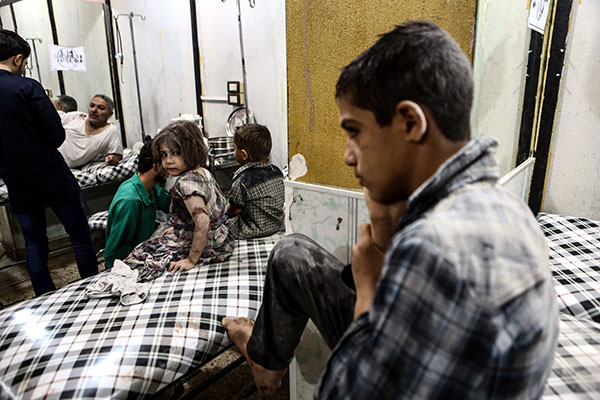
Syrian children wait to receive medical attention after
an airstrike attack near Damascus on August 23. EPA
Mena conflicts threaten two decades of health gains
LONDON, August 25, 2016
By Magdalena Mis
The Arab Spring uprising and subsequent conflicts in the Middle East and North Africa have lowered life expectancy in countries such as Syria, Yemen, Tunisia and Egypt, jeopardizing two decades of health gains, experts said on Wednesday.
Between 2010 and 2013, Yemen, Tunisia and Egypt lost some 3 months of the average person's life expectancy, while the war in Syria has erased 6 years off average life expectancy, they said in a research published in The Lancet Global Health journal.
"Life expectancy decline is traditionally regarded as a sign that the health and social systems are failing," said Ali Mokdad, a professor at the US-based University of Washington, who led the research.
"The fact that this is happening in several countries indicates there is an immediate need to invest in health care systems," he said in a statement.
Demonstrations and protests in 2011 involving hundreds of thousands of people challenged the grip on power of autocratic rulers across the Arab world.
While Tunisia managed mostly to escape the kind of violent aftershocks seen in other Arab Spring countries that toppled longstanding leaders, Egypt, Yemen and Libya are still struggling to find stability.
Conflict in Syria has killed more than 250,000 people and displaced some 11 million since it began more than five years ago as pro-democracy protests.
Many of the health gains achieved by countries in the region are at risk of stalling as fighting has damaged basic infrastructure while millions are at risk of disease outbreaks caused by water shortages and poor sanitation, the experts said.
"Along with population growth and aging, these ongoing conflicts have dramatically increased the burden of chronic diseases and injuries and many health workers have fled for safer shores," said Mokdad.
"These issues will result in deteriorating health conditions in many countries for many years and will put a strain on already scarce resources."
Syria is falling behind countries sub-Saharan Africa in reducing child mortality, with infant deaths rising by 9.1 percent a year between 2010 and 2013.
In the decade before 2010 they were falling at an average of 6 percent a year, the study said.
Across the region, heart disease was the number one cause of death in 2013, overtaking diarrheal diseases and respiratory infections, it said.
Deaths from diabetes rose to 19 per 100,000 people from 12 per 100,000 between 1990 and 2013, said the experts, warning that such trends will put an additional strain on already scarce finances and human resources.
The researchers analyzed patterns of poor health and deaths in the region due to 306 diseases and injuries between 1990 to 2013, using data from the Global Burden of Disease Study 2013. - Thomson Reuters Foundation







